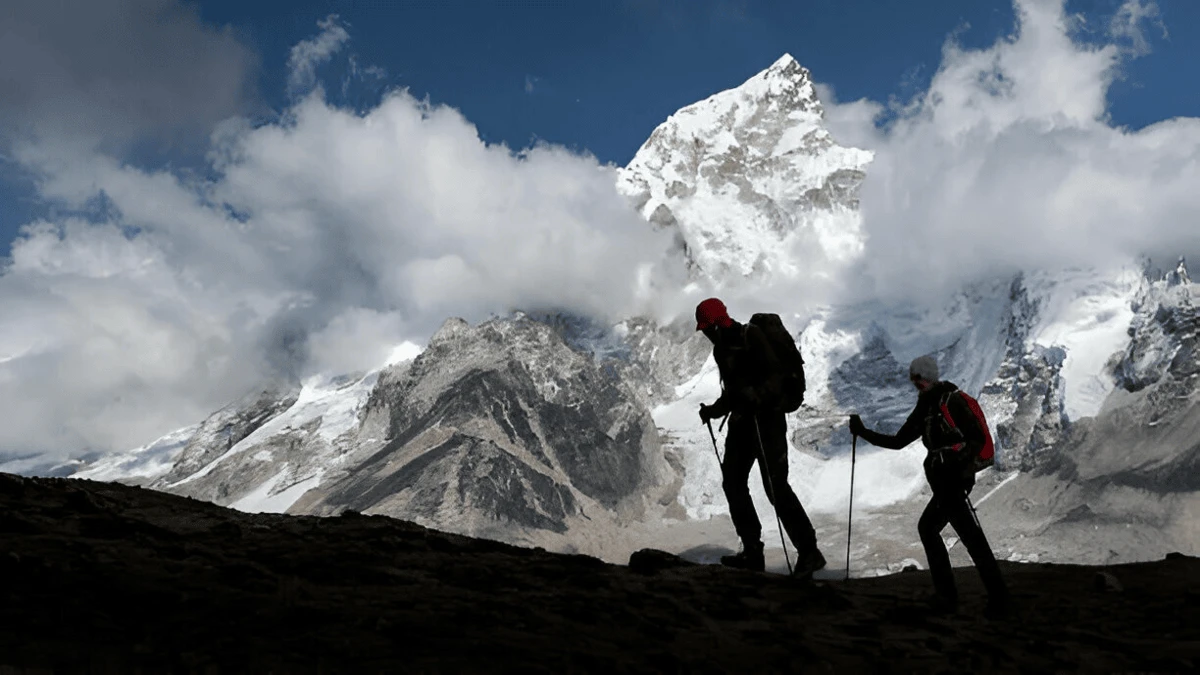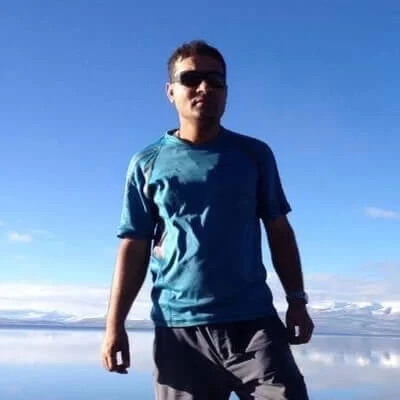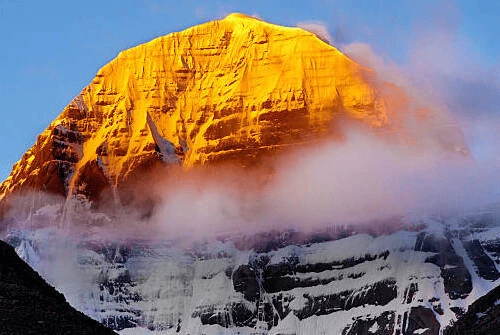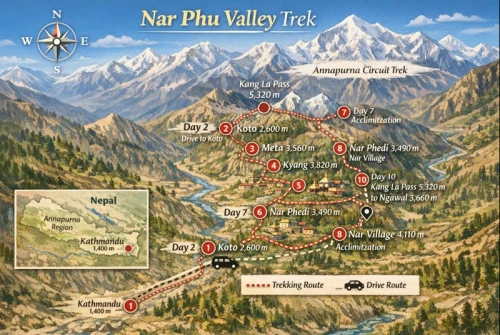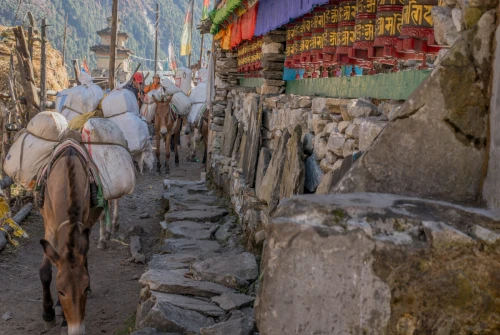When is the best time to trek in the Everest region?
The Everest region experiences distinct seasonal variations that greatly affect trekking conditions. The two best seasons for trekking are spring (March to May) and autumn (September to November).
During spring, the lower and mid-altitude forests and hills come alive with vibrant rhododendron blooms, creating stunning landscapes along the trails. Temperatures are warmer compared to winter, especially at lower elevations (1,400–3,000 meters), making hiking more comfortable. The skies are generally clear, offering spectacular mountain views of peaks such as Everest, Lhotse, and Ama Dablam.
The autumn season is considered the most popular trekking period because of its clear skies and dry weather. After the monsoon rains, the atmosphere is clean, providing excellent visibility for panoramic Himalayan vistas. Stable weather conditions prevail across elevations, from the lower valleys up to high passes above 5,000 meters. This season offers ideal trekking conditions with comfortable daytime temperatures and crisp, cool nights.
It is advisable to avoid trekking during the monsoon season (June to August) due to heavy rainfall, slippery trails, and increased risk of landslides in the mountainous terrain. The monsoon brings dense cloud cover, reducing visibility and making flights to Lukla more unpredictable.
Similarly, the extreme winter months (December to February) can be very harsh, especially at higher altitudes. Temperatures can drop well below freezing, with frequent snowfall and strong winds, making trekking challenging and potentially dangerous for inexperienced hikers.
In summary, spring and autumn offer the best combination of weather, natural beauty, and safe trekking conditions in the Himalayan geography of the Everest region.
What trekking permits are required for the Everest region?
Before embarking on the legendary trails of the Everest Region, it is essential to obtain the necessary trekking permits. Whether you plan to trek to Everest Base Camp, explore the Gokyo Lakes, or challenge the Three Passes Trek, all trekkers must carry two official permits to enter and trek within this protected area.
What permits do you need?
For trekking in the Sagarmatha National Park area (altitudes ranging from about 2,860 meters in Lukla to over 5,300 meters at Everest Base Camp), you need:
Sagarmatha National Park Entry Permit: This permit grants access to Sagarmatha National Park, a UNESCO World Heritage Site that encompasses Mount Everest and its surrounding alpine ecosystem. The park protects fragile flora, fauna, and the unique high-altitude environment.
Khumbu Pasang Lhamu Rural Municipality Entry Permit: This local government permit supports infrastructure development, waste management, trail maintenance, and emergency rescue services in the Khumbu region.
Where can you obtain these permits?
In Kathmandu, visit the Nepal Tourism Board (NTB) office at Bhrikutimandap to get the Sagarmatha National Park permit.
In Lukla, the Khumbu Rural Municipality Office near the airport issues the local permit upon arrival.
In Monjo, if you haven’t pre-arranged permits, both can be obtained at the park checkpoint just before entering Sagarmatha National Park.
If trekking with a licensed trekking agency, they usually handle all permit arrangements on your behalf.
How much do the permits cost?
Permit Type | Foreign Nationals | SAARC Nationals |
Sagarmatha National Park Permit | NPR 3,000 (~USD 25) | NPR 1,500 |
Khumbu Pasang Lhamu Permit | NPR 2,000 (~USD 15–16) | NPR 2,000 |
Why are these permits required?
These permits serve several critical purposes:
- Environmental protection: Fees help preserve the delicate alpine ecosystem within Sagarmatha National Park.
- Infrastructure funding: Permit fees support trail upkeep, waste disposal, and rescue operations in the remote mountain region.
- Safety and monitoring: Authorities use permit data to track trekkers for search and rescue missions if needed.
Who needs these permits?
- All foreign nationals trekking in the Everest Region must carry both permits, regardless of route or trekking style.
- Citizens of SAARC countries receive discounted rates.
- Nepali citizens are exempt from permit fees but must present valid citizenship documents.
- Even solo trekkers without guides are required to have these permits.
- Most trekkers flying into Lukla get the Khumbu Pasang Lhamu permit in Lukla and the Sagarmatha permit in Monjo.
What should you bring to obtain the permits?
- Original passport and a photocopy.
- Two passport-sized photos (sometimes optional but recommended).
- A copy of your itinerary or trekking route.
- Cash in Nepalese Rupees for payment.
Fly to Lukla and what are the alternatives?
Most trekkers begin their Everest Base Camp trek by flying from Kathmandu to Lukla. The flight is approximately 30 minutes long and is known for its breathtaking views of the Himalayas, including towering peaks and deep valleys. This route is the fastest and most popular way to reach the starting point of the trek.
During the busy trekking seasons, an alternative option is to fly from Kathmandu to Ramechhap (Manthali) first. From Ramechhap, trekkers take a short connecting flight to Lukla. This route can sometimes have better flight availability and fewer cancellations compared to direct flights from Kathmandu.
For those seeking a more traditional and immersive experience, trekking to Lukla from Jiri or Salleri is an excellent choice. This option adds several days to the trek but offers a chance to explore rural Nepalese villages, interact with locals, and gradually acclimatize to higher altitudes before reaching Lukla.
It is important to note that flights to Lukla are highly dependent on weather conditions. The region’s unpredictable mountain weather often causes flight delays and cancellations, especially during the monsoon and winter seasons. Because of this, trekkers are advised to include buffer days in their itinerary to accommodate any unforeseen changes in flight schedules.
What are the options for choosing the right trekking route?
Everest Base Camp is the most famous trek, but there are several other incredible trekking routes in the region to consider. One popular alternative is the Gokyo Lakes Trek, which offers stunning turquoise lakes and fewer crowds.
Another challenging and rewarding option is the Three Passes Trek, which crosses three high mountain passes and provides spectacular panoramic views of Everest and surrounding peaks.
The Tengboche Monastery Trek is a cultural route that includes a visit to the famous Tengboche Monastery, an important spiritual site for the Sherpa people.
For a more traditional experience, some trekkers choose the EBC via Jiri route, which starts with a long trek from Jiri to Lukla, allowing better acclimatization and exposure to rural Nepalese life.
If comfort is a priority, the Luxury Lodge Trek is an excellent choice. This route includes stays at high-end lodges with modern amenities, catering to trekkers who prefer comfort alongside adventure.
When choosing the right trekking route, consider important factors such as duration, difficulty level, and crowd levels to find the best fit for your preferences and fitness.
What is the dining and accommodation quality like on the Everest trek?
The quality of dining and accommodation in the Everest region has significantly improved over recent years, driven by increasing numbers of trekkers and efforts by local communities to cater to international visitors. Even at higher altitudes such as in villages like Dingboche (4,410 m) or Lobuche (4,940 m) many teahouses now offer a wider range of amenities than before.
Some teahouses in larger hubs such as Namche Bazaar (3,440 m) and Tengboche (3,860 m) have upgraded their facilities to include attached bathrooms, which provide added comfort and privacy compared to the traditional shared toilet facilities common along the trail. In these places, it is increasingly common to find Western-style food options like pizza, pasta, and specialty coffee drinks such as cappuccinos, which cater to trekkers seeking familiar tastes during their journey.
Despite these improvements, the quality of both food and accommodation generally declines as you ascend to more remote and higher-elevation settlements. Villages like Gorak Shep (5,164 m) or near Everest Base Camp (5,364 m) still offer very basic lodgings, often with cold rooms and limited hot water availability. Electricity is usually supplied by solar panels or generators and might be intermittent.
Food options in these remote locations tend to be more limited and reliant on staple items like dal bhat (lentil soup with rice), noodles, and simple snacks, since most supplies must be carried in by porters or flown in by helicopter. However, the quality is generally sufficient to keep trekkers energized and nourished for the physically demanding days ahead.
One of the most critical health precautions on the trek is to always consume purified or boiled water. Untreated water from streams or taps can carry harmful bacteria or parasites, leading to illnesses that can jeopardize your trek. Many teahouses offer boiled water or bottled mineral water for purchase. Carrying a personal water filter or purification tablets is also highly recommended for trekkers who want to be extra cautious.
Overall, while the Everest trekking trail offers surprisingly good amenities compared to other remote mountain regions, it remains essential to be prepared for basic conditions at higher altitudes and to respect the limits of local infrastructure.
What physical and mental preparation is needed for trekking?
The Everest region’s trekking routes range in altitude from about 1,400 meters in Kathmandu to over 5,300 meters at Everest Base Camp. This altitude change requires careful physical preparation.
It is recommended to start training at least 6 to 8 weeks before your trek. Training should include long hikes with a weighted backpack to simulate trekking conditions on uneven mountain trails.
Engage in cardiovascular exercises such as stair climbing, running, and cycling to improve your stamina and increase lung capacity, which helps your body adapt to the lower oxygen levels at high altitude.
Focus on strength training for your legs, back, and core muscles. Strong muscles improve your balance and endurance on steep and rocky terrain, reducing the risk of injury.
Mentally prepare for limited comforts such as basic lodges at high altitude, where amenities like hot water and internet may be scarce. Expect fatigue from altitude and long days of walking, and be ready to face unpredictable mountain weather including cold, wind, and sudden storms.
Building mental resilience and flexibility is crucial for adapting to the physical and environmental challenges of trekking in the Himalayan terrain.
How do you deal with high altitude during trekking?
Acute Mountain Sickness (AMS) is the most common and serious risk when trekking in the Everest region, where altitudes can rise from about 2,860 meters in Lukla to over 5,300 meters at Everest Base Camp. At higher elevations, the air contains less oxygen, which can cause symptoms such as headache, nausea, dizziness, and fatigue.
What are the best ways to prevent AMS?
- Ascend slowly: It is crucial to gain altitude gradually to allow your body to acclimatize. Experts recommend not increasing your sleeping altitude by more than 300–500 meters per day once above 3,000 meters.
- Take acclimatization days: Plan rest days every few days to give your body time to adjust to higher altitudes. Staying in villages like Namche Bazaar (3,440 meters) or Dingboche (4,410 meters) helps your body adapt.
- Sleep low after hiking high: The practice of “climb high, sleep low” helps improve acclimatization by hiking to higher altitudes during the day but returning to a lower elevation to sleep.
- Stay hydrated: Drinking plenty of water is essential to prevent dehydration, which can worsen altitude sickness symptoms. Aim for at least 3–4 liters of water daily.
- Avoid alcohol and smoking: Both can reduce oxygen levels in the blood and impair your body’s ability to acclimatize.
- Take Diamox if needed: This medication (acetazolamide) can help prevent and reduce symptoms of AMS. However, it should only be taken after consulting with a healthcare professional.
Why is altitude sickness a concern in the Everest region?
The rapid changes in altitude combined with physically demanding trekking on rugged terrain increase the risk of AMS. Symptoms can worsen quickly and, if untreated, may lead to more serious conditions like High Altitude Pulmonary Edema (HAPE) or High Altitude Cerebral Edema (HACE), both of which are life-threatening.
Understanding the geography of the trek and respecting your body’s limits by following these prevention strategies will help ensure a safe and enjoyable trekking experience in the Himalayas.
What should you expect from teahouse trekking culture in the Everest region?
When trekking in the Everest region, most trekkers stay in teahouses, which are basic mountain lodges scattered along the trail from lower elevations like Lukla to higher villages such as Namche Bazaar. These teahouses usually offer simple twin rooms with basic beds and shared toilet facilities.
Meals served at the teahouses typically include traditional Nepalese dishes like dal bhat (lentil soup with rice), noodles, pancakes, and plenty of tea, including Sherpa tea, which is a salty butter tea popular in the region.
Hot showers are sometimes available but usually come at an extra cost. Similarly, power outlets for charging electronic devices like phones and cameras are provided in many teahouses, though this service often requires payment as well.
It is important to respect local customs while trekking through the Khumbu region. Supporting the teahouses by purchasing meals and drinks if you stay overnight helps sustain the local economy and the families that run these lodges.
How should you budget for trekking in the Everest region?
The estimated daily cost for trekking in the Everest region ranges from approximately $25 to $50 USD per day if you are trekking without a guide or porter. Your budget should cover basic accommodation and food expenses in the teahouses along the trail.
Additional costs to consider include fees for hot showers, which are often charged separately, and WiFi access, which is usually available in larger villages like Namche Bazaar but may also require payment. Charging your electronic devices at teahouses may come with a small fee as well.
You must also budget for trekking permits, such as the Sagarmatha National Park permit and the Khumbu Pasang Lhamu Rural Municipality permit, which are mandatory for all trekkers in the region.
Don’t forget to set aside money for tips for guides, porters, and lodge staff, which is an important part of trekking culture in Nepal.
The Everest Base Camp trek tends to be more expensive than other treks in the region because of its remoteness and popularity. Prices for accommodation, food, and services generally increase with altitude and distance from major towns.
What is connectivity like while trekking in the Everest region?
Internet access in the Everest region is available primarily through Everest Link, a local satellite internet provider, or by purchasing WiFi cards at teahouses and lodges along the trail. However, connectivity can be slow and unreliable in remote areas.
Mobile networks such as NTC and Ncell work in some villages and towns, including Lukla and Namche Bazaar, but signal strength often weakens at higher altitudes and in more isolated locations.
For safety and convenience, it is best to download maps and important information offline before your trek and be prepared to go semi-off-grid during parts of the journey where connectivity is limited or unavailable.
Carrying power banks is essential to keep your devices charged, especially since charging options can be limited or require payment at teahouses.
Why and how should you hire porters and guides for the Everest trek?
Hiring a guide during your Everest trek adds an important layer of safety, helps with navigation, and provides valuable cultural context about the Sherpa communities and the region’s history. Guides also manage logistics, like arranging accommodations and permits.
A porter can carry up to 20–25 kilograms of your gear, which helps reduce your physical strain and allows you to better manage altitude fatigue on challenging mountain trails.
Hiring porters and guides not only makes your trek easier but also directly supports the local economy by providing jobs to Sherpa families in the Khumbu region.
It is highly recommended to hire through reputable trekking companies to ensure fair wages, proper insurance, and ethical treatment of porters and guides.
What are the training and fitness requirements for trekking in the Everest region?
You don’t need to be a professional athlete to complete the trek to Everest Base Camp or other routes in the Everest region, but you must be physically fit and well-prepared to handle the physical and mental challenges of trekking at high altitudes.
Most days on the trail involve hiking for 4 to 8 hours, often on uneven, rocky, and steep terrain. The combination of distance, elevation gain, and altitude can make even moderate hikes feel strenuous, so having good cardiovascular fitness and muscular endurance is essential.
One of the biggest challenges is the effect of altitude, which reduces the amount of oxygen available in the air. This makes breathing harder and increases fatigue. Therefore, your training should not only focus on general fitness but also prepare your body to cope with lower oxygen levels.
How to train effectively?
Cardiovascular exercises such as running, cycling, swimming, or stair climbing are excellent for building stamina and improving lung capacity.
Incorporate strength training that targets your legs, core, and back, as these muscle groups are heavily used during trekking.
Practice long hikes with a weighted backpack to simulate real trekking conditions. This helps your body adapt to carrying gear and walking on uneven trails.
If possible, train at higher altitudes or use altitude simulation techniques to acclimate your body before the trek.
Starting your training at least 6 to 8 weeks before your departure allows you to build the necessary endurance and strength gradually, reducing the risk of injury or exhaustion during the trek.
By investing time in proper training, you’ll increase your chances of completing the trek safely and enjoying the breathtaking scenery of the Himalayas without undue physical strain.
How difficult is the EBC trek, and what are the popular route variations?
The Everest Base Camp trek is considered moderately difficult, primarily due to the high altitude rather than the technical difficulty of the terrain itself. The trail generally follows well-established paths through the Khumbu region, with some rocky and steep sections, but nothing requiring technical climbing skills.
The main challenge is the significant altitude gain, as the trek starts around 2,860 meters in Lukla and climbs to 5,364 meters at Everest Base Camp. The reduced oxygen levels at these elevations increase fatigue and require proper acclimatization.
Popular variations of the EBC trek include:
- Gokyo Lakes via Cho La Pass: This alternative route takes trekkers through the stunning Gokyo Valley, famous for its turquoise glacial lakes, and crosses the Cho La Pass (5,420 m), a challenging high mountain pass. This route offers breathtaking views of Everest, Lhotse, and Cho Oyu, along with less crowded trails compared to the classic EBC route.
- Three Passes Circuit: This ambitious trek combines the classic EBC trail with two additional high passes Renjo La (5,360 m) and Kongma La (5,535 m) along with Cho La. The circuit usually takes 18–21 days and is suited for experienced trekkers with excellent fitness due to its demanding altitude and longer duration.
- EBC + Island Peak: For those interested in mountaineering, combining the EBC trek with an ascent of Island Peak (Imja Tse, 6,189 m) offers a thrilling challenge. Island Peak is a popular trekking peak requiring basic climbing skills and guides, attracting trekkers looking to push their limits.
How to choose the right route?
Selecting the best route depends on your available time, fitness level, and experience. The classic EBC trek is achievable for most fit trekkers and takes about 12–14 days round trip from Lukla. More challenging variations like the Three Passes Circuit or EBC combined with Island Peak require more time, better fitness, and prior trekking or climbing experience.
Proper planning and realistic assessment of your abilities will help ensure a rewarding and safe trekking experience in the Everest region.
How do you pack smart for trekking in the Everest region?
Packing smart is essential for a successful and comfortable trek in the Everest region, where weather conditions can vary dramatically between warm valley floors and freezing high-altitude passes. Being prepared with the right gear while keeping your pack light is key to managing long trekking days on rugged trails.
What are the essential items to pack?
- Layered clothing: Dressing in layers is crucial. Start with a moisture-wicking base layer to keep sweat away from your skin, add a warm fleece layer for insulation, a down jacket for cold temperatures, and a waterproof shell jacket and pants to protect against wind, rain, and snow. This layering system allows you to adapt to changing weather and altitude.
- Quality trekking boots: Sturdy, well-fitting hiking boots with good ankle support and grip are a must. They should be broken in before the trek to prevent blisters and discomfort on uneven Himalayan trails.
- Sleeping bag: A sleeping bag rated for -10°C or colder is recommended since nighttime temperatures can drop well below freezing in higher-altitude teahouses.
- First aid kit: Carry a compact kit that includes essentials such as blister treatment, pain relievers, altitude sickness medication, bandages, antiseptic wipes, and any personal medications.
- Water purification: Since drinking untreated water can cause illness, bring water purification tablets, a filter, or UV purifier to ensure safe hydration from natural water sources or tap water at lodges.
- Energy snacks: High-energy snacks like nuts, energy bars, chocolate, and dried fruits will help maintain your stamina on long trekking days.
Extra tips for packing light and smart
- Aim to keep your total pack weight between 10 to 12 kilograms (22 to 26 pounds) to avoid unnecessary strain. Overpacking can slow you down and increase fatigue.
- Use a well-fitted daypack for daily essentials such as water bottles, camera, sunscreen, sunglasses, hat, extra layers, and trekking poles.
- It’s a good idea to prepare a checklist to avoid forgetting important gear and to prevent packing redundant items.
Is the Everest Base Camp Trek worth it?
The Everest Base Camp trek is widely regarded as one of the most rewarding trekking experiences in the world, especially if you are well-prepared physically, mentally, and logistically.
What makes the EBC trek so special?
You will be treated to jaw-dropping views of the Himalayas, including some of the highest peaks on Earth such as Mount Everest (8,848 m), Lhotse, and Ama Dablam. The dramatic landscapes of glaciers, rugged mountain passes, and serene alpine valleys create unforgettable scenery at every turn.
Along the way, you’ll encounter the warm hospitality of the Sherpa people, who live in the Khumbu region. Their rich culture, traditions, and friendliness add a deeply meaningful human connection to your journey.
Completing the trek brings a profound sense of achievement. Reaching Everest Base Camp at over 5,300 meters is a testament to your endurance, determination, and ability to overcome the challenges of high-altitude trekking.
What challenges should you expect?
The trek is not easy. You should be prepared for discomfort, including cold temperatures (especially at night), fatigue from long days of hiking and the effects of altitude, and sometimes unpredictable weather. The trails can be rough, and basic accommodations add to the rugged adventure.
Despite these challenges, most trekkers describe the EBC trek as a life-changing experience. The combination of spectacular natural beauty, cultural immersion, and personal accomplishment make it a bucket-list journey for adventurers worldwide.
Top 12 FAQs: Things to Know Before Trekking in the Everest Region
1. What is the best time to trek to Everest Base Camp?
The ideal seasons are pre-monsoon (March to May) and post-monsoon (September to November). These months offer clear skies, stable weather, and optimal mountain views. Winter treks are possible but colder, and monsoon season brings heavy rain and flight disruptions.
2. Do I need a guide and porter for the Everest Base Camp trek?
While it’s possible to trek independently, hiring a licensed guide ensures safety, navigation, and cultural insight. A porter can ease your physical burden by carrying your luggage. For beginners or solo travelers, a guide and porter are highly recommended.
3. What permits are required for the EBC trek?
You need the following permits:
Sagarmatha National Park Entry Permit ($30 USD)
Khumbu Pasang Lhamu Rural Municipality Permit ($20 USD)
TIMS Card (if required) – around $20 USD
These permits are mandatory and help fund conservation and rescue services.
4. How fit do I need to be for the trek?
Trekking to Everest Base Camp requires moderate to high fitness. You should be comfortable walking 5–8 hours daily on varied terrain and at high altitude. Pre-trek training involving cardio, strength, and endurance exercises is recommended.
5. How do I avoid altitude sickness?
Proper acclimatization is key. Spend rest days at critical elevations (like Namche Bazaar), hydrate regularly, avoid alcohol, and ascend gradually. Know the symptoms of Acute Mountain Sickness (AMS) and consider carrying Diamox (with a doctor’s advice).
6. What’s the average cost of the Everest Base Camp trek?
The total cost can range from $800 to $3,000+, depending on your style of trekking. Budget travelers can stay in tea houses with basic amenities, while luxury trekkers may opt for high-end lodges, helicopter returns, and full support staff.
7. Is travel insurance necessary for the EBC trek?
Yes, absolutely. Your insurance must cover high-altitude trekking (above 5,000 meters) and include emergency evacuation (like helicopter rescue), medical care, and trip interruption. Without it, emergency services can be extremely costly.
8. What kind of accommodation is available on the trek?
Most trekkers stay in tea houses, which are local guesthouses offering basic rooms with twin beds, shared bathrooms, and meals. In lower elevations, you’ll find better facilities like hot showers, charging points, and WiFi (often for a small fee), while higher up the comfort level decreases. Luxury lodges are also available in certain areas like Namche and Dingboche for those who prefer more comfort.
9. How cold does it get during the trek?
Temperatures vary with altitude and season. At higher altitudes like Gorakshep or Lobuche, nighttime temperatures can drop to -10°C (14°F) or lower, especially in winter and early spring. Proper thermal layering, down jackets, and a quality sleeping bag rated for sub-zero temperatures are essential.
10. Can I charge my electronics on the trail?
Yes, but charging comes at a cost. Most tea houses offer paid charging services ($2–$5 per hour/device), and power supply becomes limited and solar-based at higher altitudes. It’s wise to carry power banks or solar chargers to keep your gear going.
11. Is there an internet or mobile signal on the trail?
Yes, but it’s spotty. WiFi is available in most villages for a fee (via Everest Link or Airlink cards), and Nepali SIM cards (NCELL/Nepal Telecom) often work in lower regions. However, signal strength diminishes the higher you go. Don’t rely on constant connectivity—offline maps and apps are your friends.
12. What food is available during the trek?
Most tea houses offer a menu with Nepali staples (like dal bhat), Tibetan dishes, pasta, rice, soups, and even pancakes and pizzas. The food is carbohydrate-rich for energy. Meat is available but not recommended above Namche Bazaar due to poor refrigeration.
Final Words: How to make your Everest Region trek unforgettable and safe
Trekking in the Everest Region is truly an unforgettable adventure, offering some of the most spectacular mountain scenery and cultural experiences in the world. However, this adventure will only be as rewarding as your level of preparation allows.
Being well-informed about key aspects such as permits, packing smart, physical training, budgeting, and altitude awareness will help you trek smarter and safer. Proper preparation reduces risks and maximizes your enjoyment of the breathtaking Himalayan landscapes.
Whether your goal is to reach the iconic Everest Base Camp, or you prefer to explore quieter and less crowded trails like the Gokyo Lakes or the Three Passes Circuit, always remember that the mountain environment demands respect and responsible trekking.
By respecting local customs, supporting the Sherpa communities through ethical hiring of guides and porters, and practicing sustainable trekking habits, you contribute to preserving this fragile alpine ecosystem and the culture that thrives here.
In the end, the Everest Region rewards those who are prepared, patient, and respectful offering memories and experiences that will stay with you for a lifetime.
